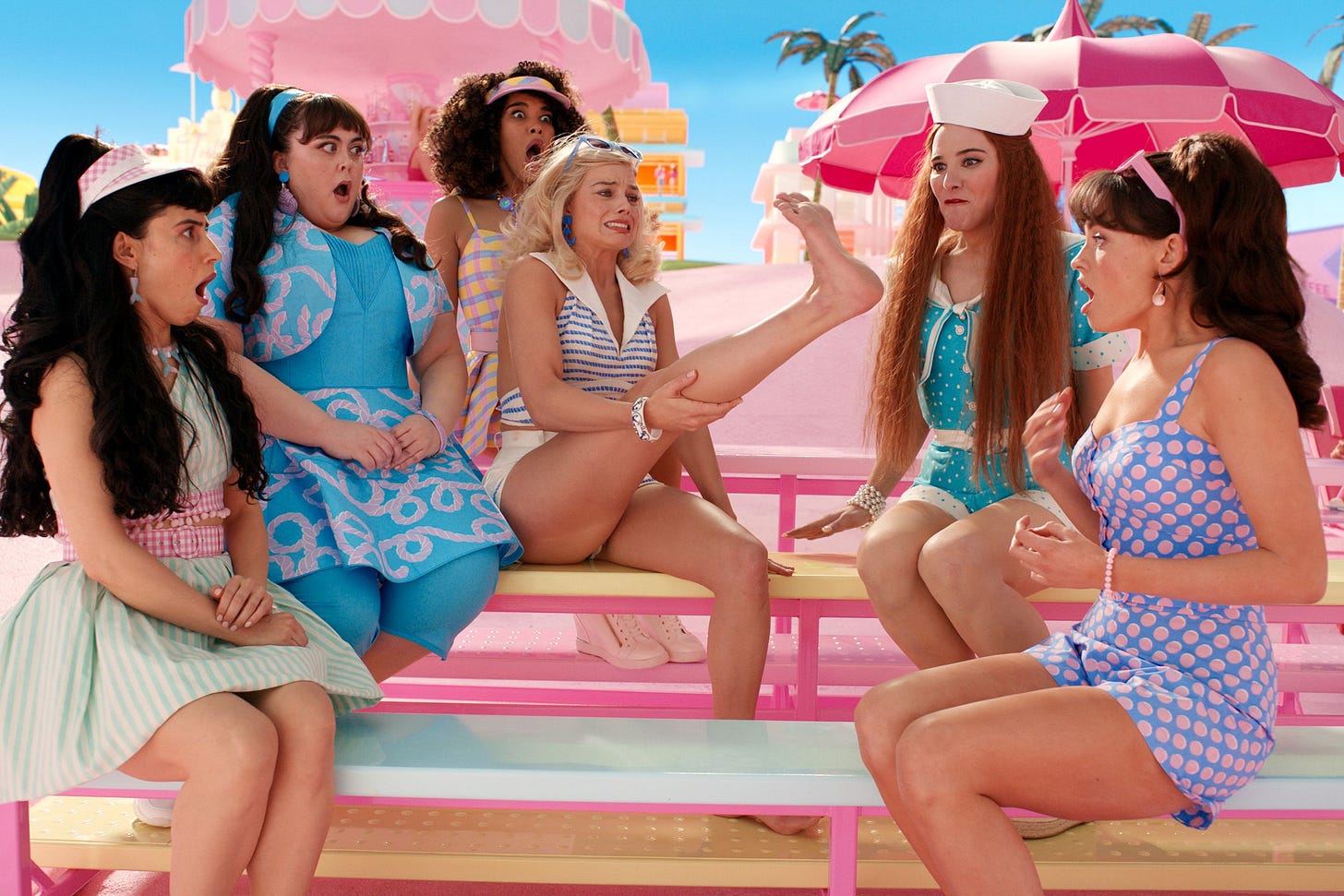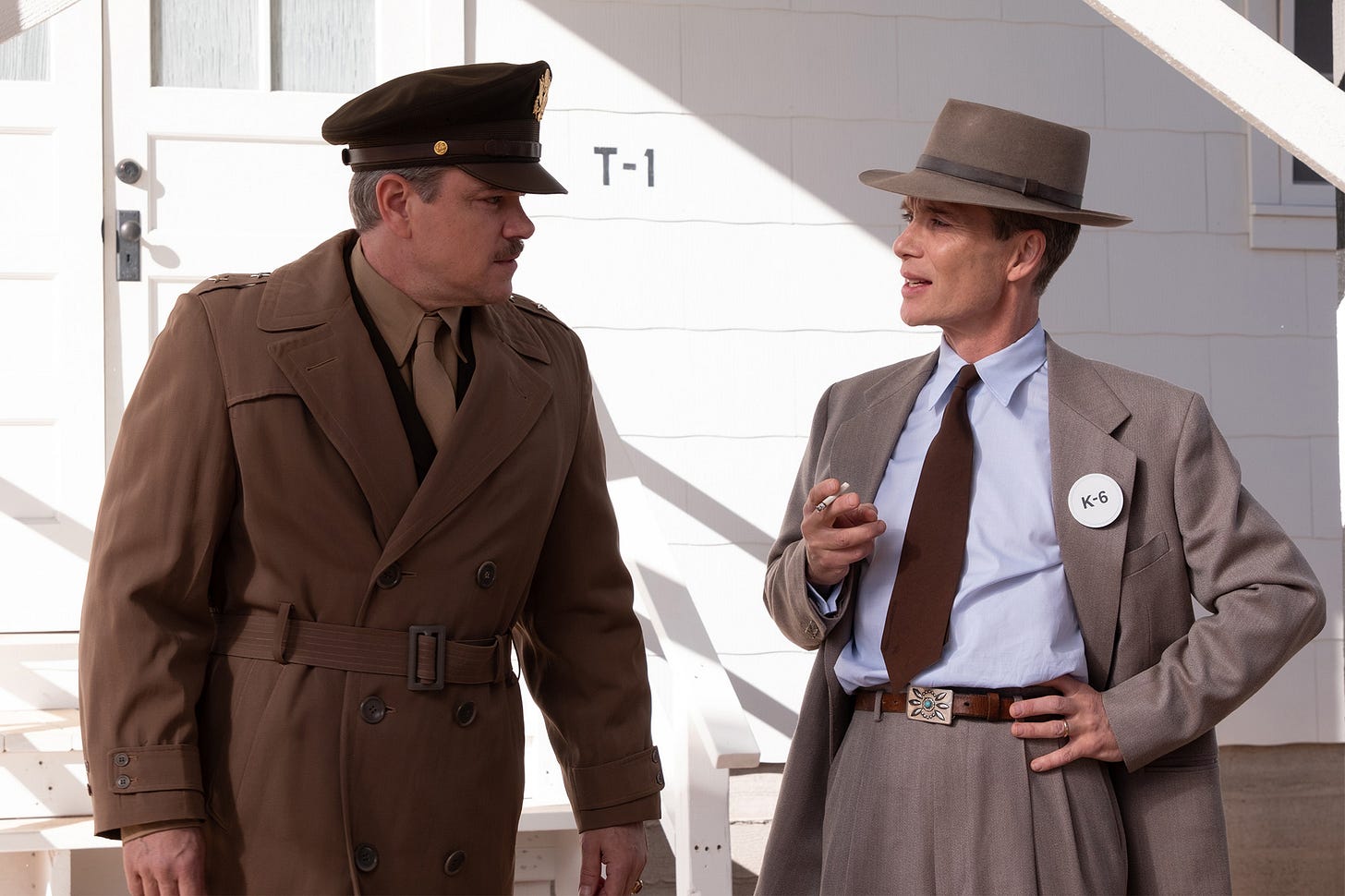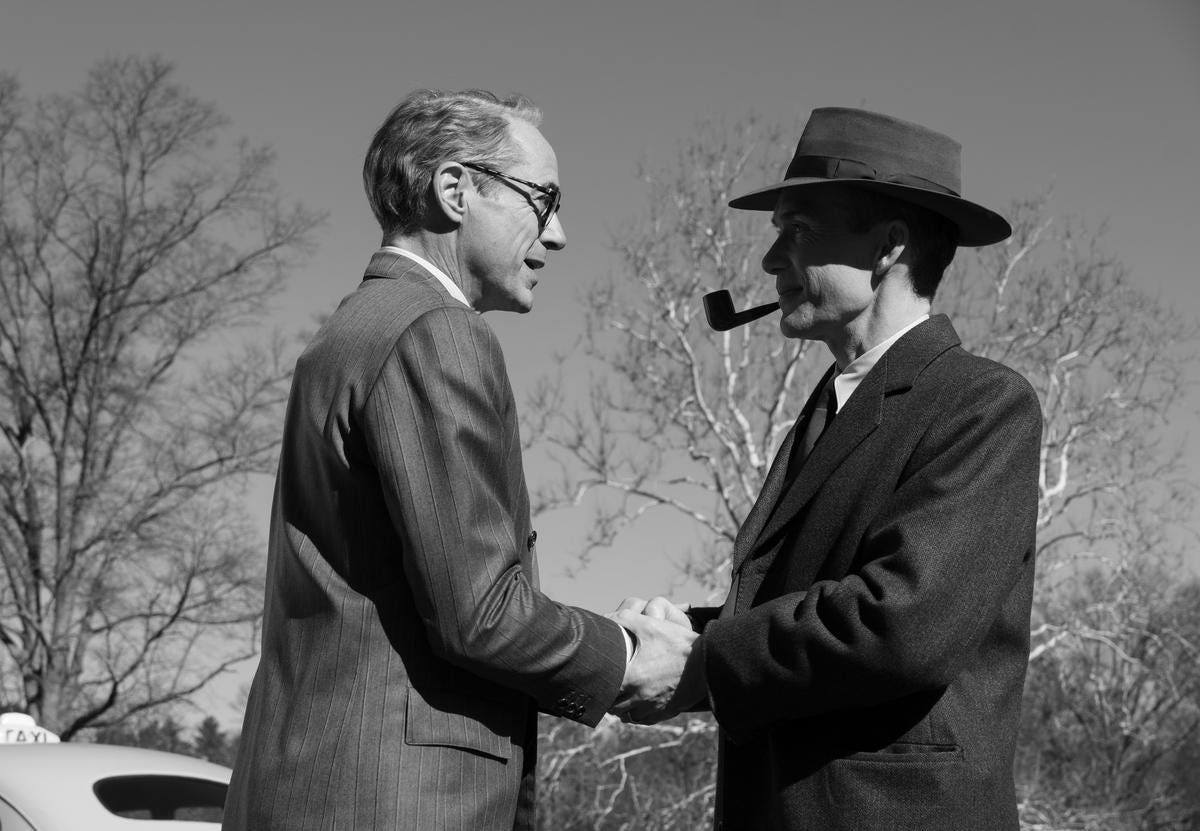The Barbenheimer Analysis
On July 21st, 2023, two movies from singular auteurs opened one of the biggest box-office weekends in history.
To all the as-yet unconverted Barbenheimer masses, a word of warning: watch Oppenheimer first, Barbie second. I made the mistake of watching them the other way around. As it turns out, a bright-pink musical comedy does not easily segue into the emotional burden of atomic destruction—you end the night overwhelmed and unsettled. Please instead begin with the nuclear horror of Oppenheimer, then get airlifted into the Day-Glo heaven of Barbie. This seems like the healthier approach.
Not that Barbenheimer is anything close to a healthy experience. It’s insane that so many people around the world are willing to subject themselves to this irony-laden double feature, all the more so since it started as a meme. “Hey look!” read the subtext of those first Tweets on the subject. “Barbie and Oppenheimer are dropping on the same day! Isn’t that funny?” Funny enough, apparently, to spur a movement has propelled Oppenheimer towards a staggering $400 million at the global box office—mind-boggling numbers for a three-hour biopic on nuclear energy—while Barbie has so far made a record-shattering $774 million. What was once just an internet meme has now transformed into a genuine cultural phenomenon. And what a cultural phenomenon it is! We’re living in a world in which plastic blondes and nuclear holocaust can somehow add to each other’s success rather than subtract from it—let’s appreciate that while we can.
The Barbie Experience
When I entered my Barbie screening on a hot Seattle afternoon, pink was the only color in sight. The theater in which my friends and I watched the film (the great SIFF Cinema Egyptian) was jam-packed with moviegoers, each of whom were dressed in varying shades of extravagant, rose-tinted outfits. Instead of movie trailers, the “Barbie Girl” music video played on wide screen. The theater itself was armed to the teeth with various Barbie paraphernalia. It’s to the credit of the Warner Bros. marketing division that Barbie has become the event that it is, with hordes upon hordes of theaters and theatergoers gleefully embracing this neon phenomenon.
The film itself plays brilliantly to these neon expectations. Much like its audience, Barbie is a thoroughly satisfying hodgepodge of political pontifications, scatterbrained playfulness, and insidious corporate interests. It is a film which tells a feminist parable through the lens of an American toy corporation—a source of abject irony, to be sure, and Barbie is well aware of its own absurdity. It assumes that its viewers are in on the joke (they are), and then takes that joke to the point of no return. “What would happen if a Barbie experienced thoughts of death?” asks the film to its audience with a winking smile. The absurdity goes further: “What would happen if a Barbie were to confront her corporate creators? What if a Ken discovered the possibility of the patriarchy?”
Such are the narrative conflicts that emerge in Barbieland, a matriarchal idyll in which “all problems of feminism of equal rights have been solved” (so says a narrator voiced by Helen Mirren). This is a cotton-candy utopia filled where Barbies—doctors, lawyers, presidents—rule the world, played by a cast that includes Emma Mackey, Alexandra Shipp, and Issa Rae. Their spiritual centerpiece is Margot Robbie’s Stereotypical Barbie: a thin blonde with an overwhelming smile. Barbieland is also filled with a cast of Kens (Simu Liu, Kingsley Ben-Adir, and Ngcuti Gatwa, among others), each as amusingly bland as the last. Their sole job, “Beach,” is as hilariously open-ended as it sounds. One of the Kens—this one played by Ryan Gosling, in an all-time musical comedy performance—is the center player among the bunch.
The plot is one of existential anxiety. It begins when Stereotypical Barbie experiences cold showers and flat-feet syndrome; it worsens when she experiences those aforementioned thoughts of death. Soon enough, Barbie and Ken (the Ryan Gosling one) embark on a quest out of Barbieland and into the real world, whereupon Barbie finds herself shocked and dismayed at a patriarchal society—as it turns out, that the Eden-like promises of Barbieland were wishful thinking. Ken, on the other hand, is elated at the prospects of male dominance, and his boyish excitement leads to many of the film’s funniest scenes. These ideas are as entertaining as they are ripe for feminist analysis, most of which can be chalked up to Greta Gerwig’s direction (from a script by Gerwig and Noah Baumbach). She is the rare director to make popcorn fun out of such intellectual concepts—a generational talent.
Gosling is the easy pick for the film’s best performance: his movie star comedy chops are on brilliant display. But Robbie’s task is the more difficult balancing act. The act of turning a doll into a recognizably human creature requires her to be both radiant and stilted, and Robbie manages both with subtlety and elan, bringing a movie star charisma to a role she deserves. Issa Rae and Simu Liu are similarly exceptional in their roles—they fuse their public personas into two incredibly funny performances—as are Kate McKinnon as the splits-bearing spiritual guide Weird Barbie, and America Ferrera as Gloria, the real-world creator/surrogate for Stereotypical Barbie.
I’d also be remiss to not mention Allan, the only non-Ken male doll of the bunch and played here by Michael Cera. Designed originally as Ken’s (ambiguously gay) best friend, Cera’s lanky, tenor-toned performance elevates Allan to Cousin Greg levels of humor. Every single thing he does is funny! How is that possible!
Not everything in the film holds together. Barbie’s final act turns the film into a Pinocchio story in which Barbie aims to become a human being, and this falls too hard into saccharinity. The same can be said for the film’s most abstract sequences. One montage involving childhood memories and a Billie Eilish original song doesn’t quite achieve the transcendence for which it aims. The worst section of the film is its middle, in which Barbie confronts Mattel’s CEO (Will Ferrell) at a Jacques Tati-esque corporate headquarters. The whole section is tacky: it has none of Barbieland’s cotton-candy pizzaz.
Perhaps we shouldn’t be surprised by this last point. Barbie is the cinematic creation of a multinational toy corporation, after all, meaning that it can only be a satire insofar as Mattel will allow. This is an unavoidable problem, but one that can be difficult to accept when product placement so clearly pervades the entire film. To enjoy Barbie, one has to accept the discomfiting fact that a toy corporation poached one of this generation’s leading directorial voices for its profiteering services. But I enjoyed Barbie anyway, not least because the film brims with dynamism and wit, and perhaps more importantly because its jokes—about fascism, white saviorism, and Mojo Dojo Casa Houses—bring alive the funniest movie of the year.
Towards the end of the film, as a Ken-on-Ken war based in a horse-based patriarchy breaks out in Barbieland (which itself has now been rechristened as “Kendom”), a musical number unexpectedly takes over. Ryan Gosling and Simu Liu face off in a magnificently choreographed all-male dance fantasia that blends the camp glory of Grease with the balletic violence of West Side Story. This sequence is exuberant: the most entertaining cinematic setpiece of the 2020s. This sequence was also built on the back of a f*cking Barbie doll. Despite the uncanny horror of having written these last few sentences, those two statements don’t cancel each other out. They elevate the film to a whole new level.
The Oppenheimer Experience
How on earth is one to transition out of this neon dreamworld and into Oppenheimer? In the moment, this back-to-back transition felt exhausting, but things began settling into place once I realized that the Barbenheimer experience is itself not dissimilar to Barbie itself: an extended practice in capitalist irony, consumptive satire in which a toy-based existential comedy somehow gains power with the knowledge that a weighty historical drama is to follow. My group left Barbie with a spring in our step—two of my friends in particular knew nothing about the film going in, and were pleasantly surprised at its adult-oriented humor. As we made our way to Oppenheimer (after a pizza dinner), we found the time to transition from Gerwig’s era-defining spectacle to a Christopher Nolan IMAX experience that comes only every few years.
Speaking of IMAX experiences, Nolan is right: Oppenheimer needs to be seen on the biggest screen possible. I’ve seen the film twice now—once at the majestically large Pacific Science Center IMAX screen, then again the next day on a standard theater projection. The difference is staggering. The harrowing scale of the Trinity Test, the subatomic particles that ricochet across J. Robert Oppenheimer’s (Cillian Murphy) mind, the gravitas present in the film’s many faces—without IMAX, these images lose some of their immersive grandeur.
Nolan whisks his audience into Oppenheimer with a narrative that recounts its protagonist’s life in fragments. Historical moments dart in and out of existence; timelines converge on different planes. In one memory labelled “fission”, Oppenheimer relates his life’s work before a tribunal of anti-communists. In another, realized in black-and-white and labelled “fusion,” ex-atomic energy commissioner Lewis Strauss (Robert Downey Jr.) recounts his interactions with the Father of the Atomic Bomb. These two narratives anchor a film that darts in and out of different timelines. With a three-hour runtime and a truly overwhelming amount of dialogue, Oppenheimer can verge on mental exhaustion. But exhaustion does not mean a lack of invigoration, and the one-two punch of Jennifer Lame’s razor-sharp editing and Ludwig Göransson’s pulse-pounding score keeps us totally enthralled. This is Oppenheimer’s most impressive quality: despite its relentless pacing, we are never once thrown overboard.
The film’s cast is extraordinarily large, with a laundry list of A- and B-listers playing what feels like every theoretical physicist to have ever lived. Josh Hartnett, Rami Malek, Kenneth Branagh, Benny Safdie, Jack Quaid, and Josh Peck(!) all have supporting roles, which is to say nothing of the film’s numerous politicians and military men. Matt Damon plays General Leslie Groves, Oppenheimer’s friend and the Manhattan Project director with his typical cowboy charisma; Casey Affleck is deliciously slimy as US intelligence officer Boris Pash; Jason Clarke plays attorney Roger Robb with McCarthyist fury. Credit goes to Nolan and casting director John Papsidera for finding performers who add emotional weight where Nolan’s script and direction cannot.
Special mention goes to Downey Jr., whose quiet rendition of Lewis Strauss reminds us just how potent an old-school movie stardom like his can be. The charisma he applied to Iron Man is applied perfectly here, and Nolan, ever an expert in subversive casting, knows just how to turn Downey’s self-obsessed charm towards thematic resonance. With Downey now out of the Marvel Machine, he looks to have the potential to turn into one of our generation’s great screen actors.
The women of Oppenheimer are woefully underserved by its auteur—a recurrent problem in Nolan’s filmography. Emily Blunt and Florence Pugh do tremendous work in thankless roles—particularly Blunt. Playing Oppenheimer’s wife Kitty, she is treated as little more than an ungrateful alcoholic who is superfluous to her husband’s life. (This, despite getting a magnificently prickly monologue near the film’s end.) This is less true of Pugh, as the character she plays—Jean Tatlock, the woman with whom Oppenheimer had an intermittent and yearslong affair—was deeply involved in the Communist Party of America, and thus within the film’s narrative: the film’s third act in particular is interested in Oppenheimer’s allegiances to the United States. Tatlock’s role in Oppenheimer’s life is as politically relevant as it is emotionally resonant, and Pugh, who can play crippling anxiety with impressive sympathy, is more than able to turn her into a well-rounded human being.
The film’s best performance goes to its leading man. Without Cillian Murphy’s haunted stare, nothing in Oppenheimer would function: we need a face that can carry the moral weight of nuclear apocalypse. As we follow Oppenheimer from his early years in the European universities to his creation of a theoretical physics department at Berkeley to his leadership of the Manhattan Project in Los Alamos, Murphy all the while brings a stoic charisma that is entirely convincing. You believe that this man could have led a ragtag group of scientists to the ends of the Earth and back.
Nolan renders J. Robert Oppenheimer as only he would: a lonely male genius in the likes of Inception’s Dom Cobb, Memento’s Leonard Shelby, and The Dark Knight trilogy’s rendition of Bruce Wayne. Like them, Oppenheimer is a man tormented by thoughts of a world beyond his own, though unlike those other films, Nolan here visualizes his protagonist’s interiority as he never has before. As Oppenheimer lies awake at night, tortured by images of an invisible subatomic world, we see those images rendered in a manner reminiscent more of David Lynch than Nolan’s trademark realism. Lights of various shapes and sizes flash intermittently on the screen; explosive sound design by Randy Torres immerses us further in this horrifying, beautiful, unpredictable universe. It’s the most visually experimental that Nolan has ever been: it success brilliantly.
Other scenes in the film pulsate with similar experimentation—and with similar emotive power. In one scene midway through the film, Oppenheimer delivers a celebratory speech before a crowd of Americans celebrating the destruction of Hiroshima and Nagasaki. Their feet stomp on the ground; the volume reaches a point that is almost too much to bear—and then all sound disappears. He then imagines the room filled with the bright light of nuclear detonation. He sees his fellow Americans suffering from the evil that he wrought on Japan. Everything is happening inside Oppenheimer’s head—again, Nolan at his most experimental—and it conveys the mind of a man plagued by a destruction-filled universe.
“You see beyond the world we live in,” says a character at one point in the film in reference to Oppenheimer’s genius. It’s an overwritten line that blatantly disobeys the “show, don’t tell” rule, but the film gets away with it, not least because he has shown us. We see the scientists, generals, and power players who have come to define the father of the atomic bomb: Nolan recounts Oppenheimer’s life with a historian’s interrogative mind. We have witnessed the Trinity Test, rendered in a filmmaking sequence of horrifying, awe-inspiring grandeur—an instant classic. We have peered inside the mind of Oppenheimer himself, a mind that knows the scale of atomic destruction more acutely than anyone else.
To restate what I said up top: Oppenheimer is not the movie with which to conclude a Barbenheimer double-bill. It is an acutely distressing experience, and a markedly powerful one. Watching the final sequence of the film on an IMAX screen, I was left bowled over and overwhelmed—not the feeling with which you want to conclude a five-hour cinema journey.
But on its own terms, Oppenheimer is a towering achievement. It manages to cinematize the life of a man with a deeply un-cinematic life. Oppenheimer is little more than a class act in Important Men Talking In Rooms, with the occasional—and significant—expressionistic flourish: Nolan has found a means of turning historical biography into narrative potency. This isn’t to say there aren’t flaws. Nolan still suffers from some of his typically overwritten dialogue; he treats some of his characters (most notably the women) as data, rather than as people in their own right; and some of his visual experimentations fall flat. (One semi-imagined sex scene does not play as it should.) But these are the markings of a singular vision that is often transcendent. Oppenheimer is the story that Nolan wanted to tell.
This is what made Barbenheimer the phenomenon that it was (and still is, given a worldwide box office that chugs ever forward). Yes, it was the memes that pointed out the absurdity of girl dolls and nuclear destruction. Yes, it was the irony of two movies competing with each other for box office dominance, only to see them alley-oop each other for mutual support. But Barbenheimer succeeds on another level, too: on the power of two visionary artists realizing singular visions onscreen.
These artists did not cancel each other out: they elevated each other to a new level.






